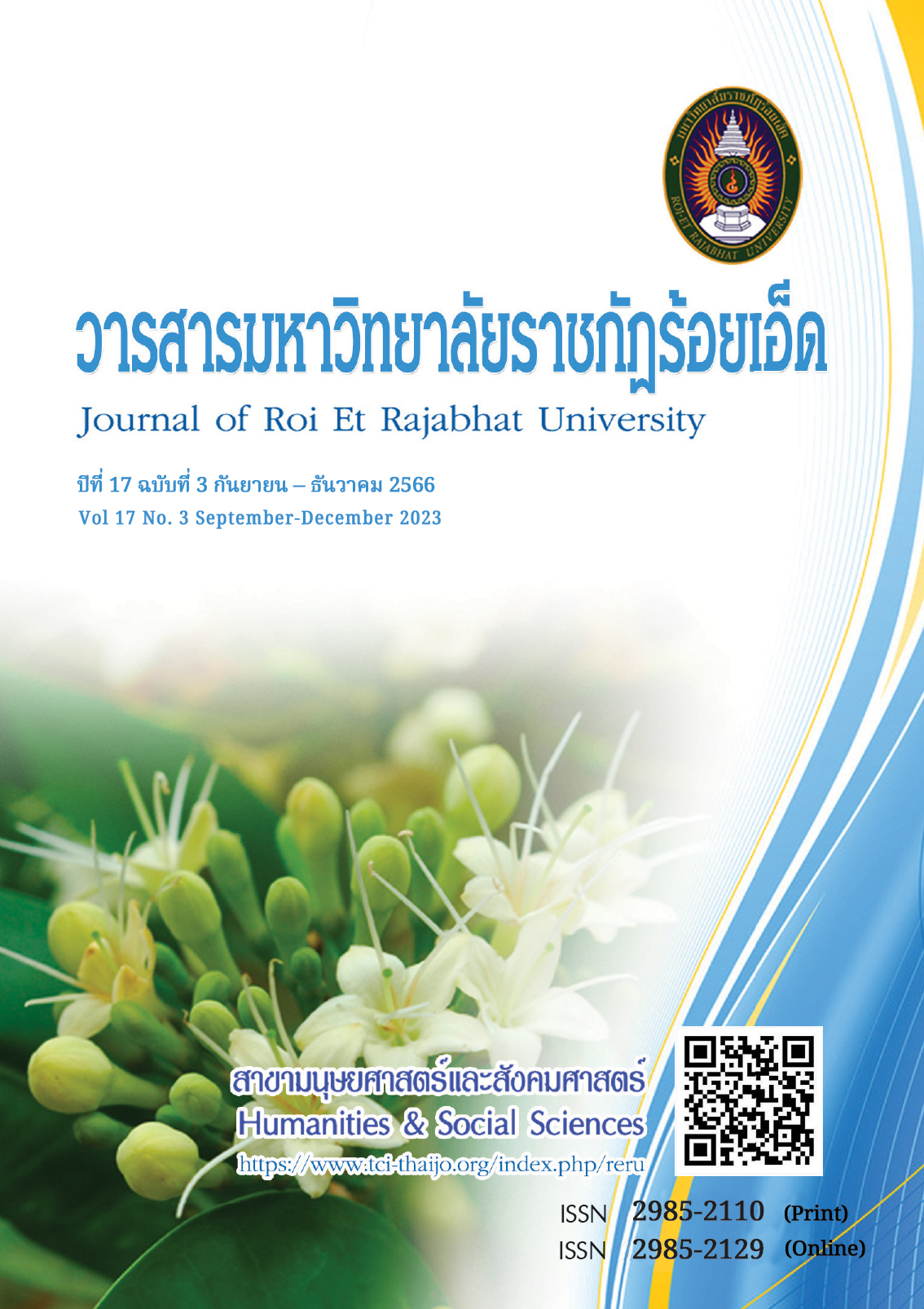รูปแบบการจัดวางเรือนกลุ่มชาติพันธุ์แสกในเมืองท่าแขก แขวงคำม่วน สาธารณรัฐประชาธิปไตยประชาชนลาว
คำสำคัญ:
สถาปัตยกรรมพื้นถิ่น, อัตลักษณ์สถาปัตยกรรมพื้นถิ่น, สัมภาระทางวัฒนธรรมบทคัดย่อ
บทความนี้เน้นการศึกษา “รูปแบบการจัดวางเรือนกลุ่มชาติพันธุ์แสก” เป็นส่วนหนึ่งของงานวิจัยเรื่องสัมภาระ
ทางวัฒนธรรมกลุ่มชาติพันธุ์แสก ใช้การศึกษาภาคสนามเก็บข้อมูลงานสถาปัตยกรรมพื้นถิ่นเกี่ยวกับการวางผังชุมชน
และตำแหน่งทิศทางเรือนของกลุ่มชาติพันธุ์แสกภายใต้บริบทความสัมพันธ์ภูมิทัศน์วัฒนธรรมกับกลุ่มชุมชนที่อาศัยอยู่ในเมืองท่าแขก แขวงคำม่วน สาธารณรัฐประชาธิปไตยประชาชนลาว ณ สภาพปัจจุบันผ่านพื้นที่หมู่บ้านกลุ่มชาติพันธุ์แสกที่ยังคงดำรงอยู่ด้วยมรดกทางวัฒนธรรมที่จับต้องไม่ได้ทางด้านภาษาพูดในระบบเครือญาติจากวิถีดำรงปัจจุบันจำนวน 4 กลุ่ม คือ หมู่บ้านท่าแค หมู่บ้านทอก หมู่บ้านนายอและหมู่บ้านโพนสว่างเพื่อทราบถึงการปรับตัวและการเปลี่ยนแปลงโดยองค์รวมผ่านบริบทกายภาพพื้นที่เกี่ยวกับการวางผังชุมชนและตำแหน่งทิศทางเรือนของกลุ่มชาติพันธุ์แสก ผลการวิจัยพบว่าการวางผังของกลุ่มชุมชนชาติพันธุ์แสกยังคงวางแนวสันหลังคาตามแนวแม่น้ำโขงอยู่เป็นส่วนใหญ่และการตั้งถิ่นฐานบริเวณพื้นที่ที่ตั้งอยู่ใกล้แหล่งน้ำชุมชนไม่ได้เป็นสิ่งกำหนดให้มีการวางผังชุมชนหรือแนวสันหลังคาเรือนตามแนวสายน้ำไหลแต่อย่างใด หากแต่ชุมชนเลือกหันทิศทางหน้าเรือนเข้าหาพื้นที่ศักดิ์สิทธิ์หรือวัดตามคติความเชื่อทางวัฒนธรรมสืบทอดเป็นหลักซึ่งถือเป็นลักษณะตามแนวคิดสัมภาระทางวัฒนธรรม
เอกสารอ้างอิง
การุณย์ ศุภมิตรโยธิน. (2562). เรือนของกลุ่มชาติพันธุ์ลาวเวียงในอีสาน: การยึดแบบแผนดั้งเดิม การปรับตัว และการผสมผสานทางวัฒนธรรม. นครราชสีมา: มหาวิทยาลัยราชภัฏนครราชสีมา.
ชลธี คำเกษ . (2553). คุณลักษณะทางสถาปัตยกรรมภายในเรือนพื้นถิ่นชาวแสก กรณีศึกษา บ้านอาจสามารถ ตำบลอาจสามารถ อำเภอเมืองนครพนม จังหวัดนครพนม. วิทยานิพนธ์ สถาปัตยกรรมศาสตรมหาบัณฑิต สาขาวิชาสถาปัตยกรรมภายใน. กรุงเทพฯ: มหาวิทยาลัยธรรมศาสตร์.
ชัยสิทธิ์ ด่านกิตติกุล และ Nittha Bounpany. (2561). การวางทิศทางของวัดในเมืองประวัติศาสตร์ หลวงพระบาง สาธารณรัฐประชาธิปไตยประชาชนลาว. วารสารหน้าจั่ว สถาปัตยกรรมการออกแบบและสภาพแวดล้อม, 33(1), 55-70.
ดวงพร คำมณี. (2544). การศึกษาชุมชนชาวแสก ศึกษากรณีหมู่บ้านอาจสามารถ ตำบลอาจสามารถ อำเภอเมืองจังหวัดนครพนม. สารนิพนธ์ ศิลปศาสตรบัณฑิต สาขาวิชามนุษย์วิทยา. กรุงเทพฯ: มหาวิทยาลัยศิลปากร.
ศรีศักร วัลลิโภดม. (2551). นครแพร่จากอดีตมาปัจจุบัน: ภูมินิเวศวัฒนธรรม ระบบความเชื่อและประวัติศาสตร์ท้องถิ่น.
กรุงเทพฯ: สำนักงานกองทุนสนับสนุนการวิจัย.
สุรจิตต์ จันทรสาขา. (2520). จังหวัดนครพนมในอดีต. กรุงเทพฯ: ศูนย์มานุษยวิทยาสิรินธร.
สุวิทย์ จิรมณี. (2545). ศิลปะสถาปัตยกรรมพื้นถิ่นอีสาน ในวัฒนธรรมไทย-ลาว. ชลบุรี: มหาวิทยาลัยบูรพา.
อรศิริ ปาณินท์. (2553). การเปลี่ยนถ่ายสัมภาระทางวัฒนธรรมของชาวพวน: จากเชียงขวางสู่ลุ่มน้ำภาคกลางของไทย.
วารสารหน้าจั่ว ว่าด้วยประวัตศาสตร์สถาปัตยกรรม และสถาปัตยกรรมไทย, 7(กันยายน 2553 - สิงหาคม 2554),
-165.
Clement, S. and Clement, P. (2003). Kirdsiri Kreangkrai (Translated in Thai) Ruen Lao: nai khet Vieng Chan and Luang Prabang. Vientien: Dokket.
Boas, F. (1940). Race, Language and Culture. New york: The Macmillan Company.
Bounpany, N. (2018). The Orientation of Temple’s Layout Plan in World Heritage Town of Luang Phrabang. Lao PDR. Bangkok: Silpakorn University.
Rapoport, A. (1990). The meaning of the built environment. Arizona: University of Arizona Press.
Schliesinger, J. (2003). Ethnic Groups of Laos: Profile of Austro-Thai-Speaking Peoples (3rd ed.). Bangkok: White Lotus.
Schliesinger, J. (2001). Thi Groups of Thailand: Profile of the Existing Groups (2nd ed.). Bangkok: White Lotus.
ดาวน์โหลด
เผยแพร่แล้ว
รูปแบบการอ้างอิง
ฉบับ
ประเภทบทความ
สัญญาอนุญาต
ลิขสิทธิ์ (c) 2023 มหาวิทยาลัยราชภัฏร้อยเอ็ด

อนุญาตภายใต้เงื่อนไข Creative Commons Attribution-NonCommercial-NoDerivatives 4.0 International License.
บทความที่ได้รับการตีพิมพ์เป็นลิขสิทธิ์ของวารสารมหาวิทยาลัยราชภัฎร้อยเอ็ด
ข้อความที่ปรากฏในบทความแต่ละเรื่องในวารสารวิชาการเล่มนี้เป็นความคิดเห็นส่วนตัวของผู้เขียนแต่ละท่านไม่เกี่ยวข้องกับมหาวิทยาลัยราชภัฎร้อยเอ็ด และคณาจารย์ท่านอื่นๆในมหาวิทยาลัยฯ แต่อย่างใด ความรับผิดชอบองค์ประกอบทั้งหมดของบทความแต่ละเรื่องเป็นของผู้เขียนแต่ละท่าน หากมีความผิดพลาดใดๆ ผู้เขียนแต่ละท่านจะรับผิดชอบบทความของตนเองแต่ผู้เดียว





